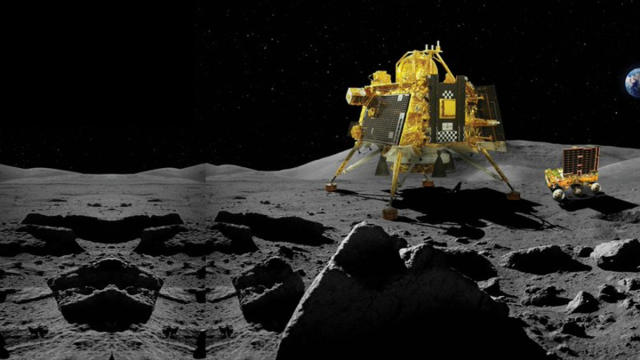The Laser-Induced Breakdown Spectroscope on the Pragyan rover, according to the Indian Space Research Organization (ISRO), made the first-ever in-situ measurements that confirmed the presence of sulphur on the lunar surface close to the south pole.
It added that the instrument also discovered other predicted elements like silicon, calcium, iron, titanium, manganese, and oxygen.
“The Laser-Induced Breakdown Spectroscopy (LIBS) instrument onboard Chandrayaan-3 Rover has made the first-ever in-situ measurements on the elemental composition of the lunar surface near the south pole. These in-situ measurements confirm the presence of Sulphur (S) in the region unambiguously, something that was not feasible by the instruments onboard the orbiters,” the space agency said in a statement.
ISRO describes LIBS as a scientific technique that analyses the chemical composition of materials by exposing them to intense laser pulses.
“A high-energy laser pulse is focused onto the surface of a material, such as a rock or soil. The laser pulse generates an extremely hot and localized plasma. The collected plasma light is spectrally resolved and detected by detectors such as Charge Coupled Devices. Since each element emits a characteristic set of wavelengths of light when it’s in a plasma state, the elemental composition of the material is determined,” it said.
On the lunar surface, preliminary analyses have revealed the presence of the elements aluminium (Al), sulphur (S), calcium (Ca), iron (Fe), chromium (Cr), and titanium (Ti). Further analysis revealed manganese (Mn), silicon (Si), and oxygen (O), according to the statement.
“Through investigation regarding the presence of Hydrogen is underway,” ISRO said.
The Laboratory for Electro-Optics Systems in Peenya Industrial Estate, Bengaluru, where the first Indian satellite was built in 1975, is where the LIBS instrument was developed.
On August 23, India made history when the Lander Module (LM) of its ambitious Chandrayaan-3 third Moon mission touched down on the lunar surface, becoming the fourth country to do so and the first to reach the uncharted south pole of Earth’s only natural satellite.
Pragyan rover encountered a crater. What happened next?
Shiv Shakti Point will be the name of the location where the Chandrayaan-3 Vikram lander made a soft landing, and Tiranga Point will be the name of the location where the Chandrayaan-2 lander crashed-landed on the surface of the Moon in 2019.
“On August 27, 2023, the Rover came across a 4-meter diameter crater positioned 3 meters ahead of its location. The Rover was commanded to retrace the path. It’s now safely heading on a new path”, ISRO had said.
Chandrayaan-3 Mission:
On August 27, 2023, the Rover came across a 4-meter diameter crater positioned 3 meters ahead of its location.
The Rover was commanded to retrace the path.It's now safely heading on a new path.#Chandrayaan_3#Ch3 pic.twitter.com/QfOmqDYvSF
— ISRO (@isro) August 28, 2023
Additionally, on August 23, when the Chandrayaan-3 lander landed on the lunar surface, would be celebrated as ‘National Space Day‘, Modi had said.










